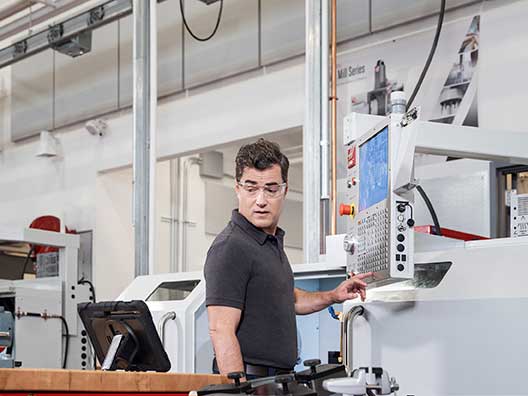Digital transformation is critical to the success of manufacturers, but to reach its potential, cybersecurity solutions must be implemented.

By Michael Weller, Practice Leader – Manufacturing, Energy and Utilities for Verizon
Supply and demand is changing. Same day-delivery is table stakes, and one-hour delivery is increasingly common. In the last few years, e-commerce grew and sustained across industries, prompted by the economic shutdown. Manufacturers and suppliers had to respond. Some are reorganizing logistics so that warehouses can be closer to customers. Others are looking for ways to shorten the timelines for sourcing parts. Both consumers and businesses demand items faster. From a technology perspective, 5G can help manufacturers streamline their operations to match growing supply needs and stay competitive in today’s marketplace, but for digital transformation to succeed, manufacturers must protect their data in the process.
A manufacturer’s efficiency depends largely on production lines staying online because if a line goes down, the consequences cascade down the supply chain. The longer a production line stays down, the more time and internal resources are spent restoring the line. The costs mount and the risk of missing delivery deadlines increase. The added urgency may also pose security and worker safety risks. All of which is to say keeping production lines running optimally can be the key to a manufacturer’s efficiency and success.
Keeping production lines running smoothly hinges on visibility into the current state of a production line and the ability to quickly identify faults along the supply chain. Multi-access edge computing (MEC) and 5G solutions combined with artificial intelligence (AI) and augmented reality (AR) technologies can provide manufacturers with end-to-end visibility and real-time logistics controls. This enhanced visibility can reduce production downtime, create transparency across the supply chain, and enable manufacturers to more effectively trace faulty items back to origin and investigate the potential cause of fault. The latter is especially valuable given how costly and time-consuming it can be to identify the root cause of a machine breakdown.
MEC and 5G bring faster processing closer to the manufacturing facility, providing low latency, which can empower companies to gather data faster to make better-informed decisions quickly. With these solutions in place, manufacturers can proactively monitor production equipment and help avoid maintenance issues and reduce unscheduled downtime.
Visibility into the current state of a production line is important, but harnessing that data in real-time is no easy task, as there is a massive amount of data on the factory floor. It can be difficult to sift through and leverage in a manner timely enough to be actionable. A digital twin can help in this regard.
With 5G technology, manufacturers can create digital twins, and with a digital twin, factory floor data is much more accessible as it creates a digital replica of any process, system, or physical asset on the floor. Digital twins can help reduce the cost, time and labor of isolating problems along production lines.
This benefit of a digital twin is enhanced when combined with advanced tools like AR and virtual reality (VR). AR can provide a digital overlay on top of a physical machine, which gives technicians a view into a machine they wouldn’t otherwise have. Technicians can also utilize VR to run simulations of potential issues that can give them insight into different possible outcomes.
Digitizing and connecting manufacturing delivers a host of new efficiencies, innovations, and possibilities, but it can also introduce new vulnerabilities. The adoption of smart manufacturing and the growing use of connected devices offers many benefits, but it also creates more potential points of entry for threat actors, including manufacturing equipment, IT, software, legacy systems and IoT devices. According to Verizon’s 2023 Data Breach Investigations Report (DBIR), most breach motives within the manufacturing industry are caused overwhelmingly by ransomware attacks, are financial in nature. In 2022 cost upwards of $2.8 million on average for victims of the breach. These breaches often necessitate the shutting down of production lines, which only compounds the problem and associated financial impact.
Protecting smart systems requires smart cybersecurity solutions. AI, powered by fast and reliable 5G connectivity, can enhance cyber programs to help identify vulnerabilities and threats, predict attacks on data, and provide alerts and recommendations for response in near real-time. This type of cybersecurity combines network connectivity, edge computing, AI capabilities, cloud technologies, and private networks.
For a manufacturer’s digital transformation to be a success, they must protect their data and intellectual property. To create a smart factory, a manufacturer must maintain smart cybersecurity, which goes beyond simply preventing breaches. It’s about building smarter, more agile enterprises with more complete visibility and more current information.

Michael is the Practice Leader for Verizon’s Manufacturing, Energy and Utilities (MEU) team. Michael’s MEU group drives strategic business development and industry engagement for VBG’s customers in these vertical markets.
In this episode, I sat down with Beejan Giga, Director | Partner and Caleb Emerson, Senior Results Manager at Carpedia International. We discussed the insights behind their recent Industry Today article, “Thinking Three Moves Ahead” and together we explored how manufacturers can plan more strategically, align with their suppliers, and build the operational discipline needed to support intentional, sustainable growth. It was a conversation packed with practical perspectives on navigating a fast-changing industry landscape.